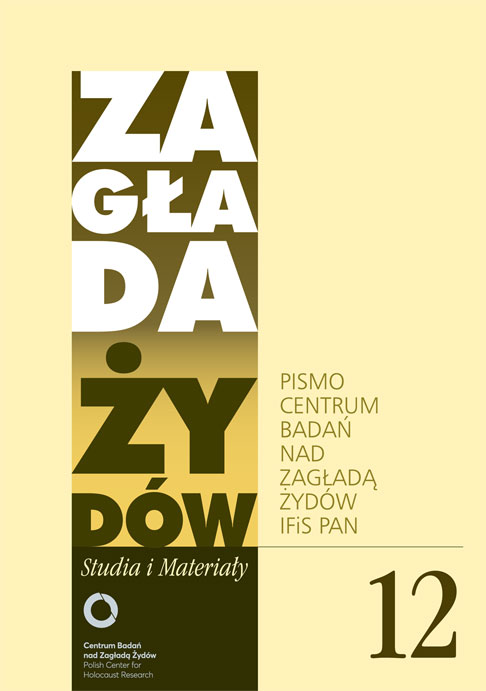Społeczeństwo holenderskie i los Żydów: skomplikowana historia
Zagłada Żydów. Studia i Materiały, Nr 12 (2016), Strony: 425-434
Data zgłoszenia: 2020-10-20Data publikacji: 2016-11-30
 https://doi.org/10.32927/ZZSiM.426
https://doi.org/10.32927/ZZSiM.426
Abstrakt
The percentage of victimization of Dutch Jewry during the Shoah is the highest of Western, Central and Southern Europe (except, perhaps of Greece), and close to the Polish one: 75%, more than 104.000 souls. The question of disproportion between the apparent favorable status of the Jews in society – they had acquired emancipation in 1796 - and the disastrous outcome of the Nazi occupation as compared to other countries in general and Western European in particular has haunted Dutch historiography of the Shoah. Who should be blamed for that outcome: the perpetrators, i.e. the Germans, the bystanders, i.e. the Dutch or the victims, i.e. the Dutch Jews? The article first surveys the answers given to this question since the beginnings of Dutch Holocaust historiography in the immediate post-war period until the debates of today and the factors that influenced the shaping of some basic perceptions on “Dutch society and the Jews”. It then proceeds to detailing several facts from the Holocaust period that are essential for an evaluation of gentile attitudes. The article concludes with the observation that – in spite of ongoing debates – the overall picture which has accumulated after decades of research will not essentially being altered. Although the Holocaust was initiated, planned and carried out from Berlin, and although a considerable number of Dutchmen helped and hid Jews and the majority definitely despised the Germans, considerable parts of Dutch society contributed to the disastrous outcome of the Jewish lot in the Netherlands – through a high amount of servility towards the German authorities, through indifference when Jewish fellow-citizens were persecuted, through economically benefiting from the persecution and from the disappearance of Jewish neighbors, and through actual collaboration (stemming from a variety of reasons). Consequently, the picture of the Holocaust in the Netherlands is multi-dimensional, but altogether puzzling and not favorable.
Słowa kluczowe
społeczeństwo holenderskie wobec Żydów , literatura o Zagładzie w Holandii
Licencja
Prawa autorskie (c) 2016 Autor&"Zagłada Żydów. Studia i Materiały"

Utwór dostępny jest na licencji Creative Commons Uznanie autorstwa 4.0 Międzynarodowe.
https://creativecommons.org/licenses/by/4.0
Czasopismo publikowane jest w standardzie Diamond Open Access na licencji CC-BY-4.0 Deed - Uznanie autorstwa 4.0 Międzynarodowa - Creative Commons
Inne teksty tego samego autora
- Avner Shalev, Dan Michman, David Silberklang, Ścisła pamięć o Zagładzie w Muzeum Historii Holokaustu w Yad Vashem. Odpowiedź na artykuł Amosa Goldberga , Zagłada Żydów. Studia i Materiały: Nr 7 (2011)
Podobne artykuły
- Dariusz Libionka, Encyclopedia of Camps and Ghettos 1933–1945, t. 2: Ghettos in German-Occupied Eastern Europe , Zagłada Żydów. Studia i Materiały: Nr 9 (2013)
- Beate Kosmala, Berlin w czasach narodowego socjalizmu i deportacja berlińskich Żydów – nowe publikacje z 2013 r. , Zagłada Żydów. Studia i Materiały: Nr 10 (2014)
- Karin Ohry-Kossoy, Agnieszka Haska, Lista Soni Wajselfisz [Karin Ohry Lista Soni; Agnieszka Haska, „Setki znajomych osób”. Lista z Bergen-Belsen] , Zagłada Żydów. Studia i Materiały: Nr 12 (2016)
- Jacek Walicki, Wydział Archiwum getta łódzkiego a Archiwum Ringelbluma , Zagłada Żydów. Studia i Materiały: Nr 16 (2020)
- Agnieszka Haska, „…udostępnione jak najszerszym rzeszom czytelników…” Wydania krytyczne prac Centralnej Żydowskiej Komisji Historycznej seria ŻIH Żydowskiej Komisji Historycznej , Zagłada Żydów. Studia i Materiały: Nr 16 (2020)
- Agnieszka Haska, Frédéric Rousseau, Żydowskie dziecko z Warszawy. Historia pewnej fotografii , Zagłada Żydów. Studia i Materiały: Nr 10 (2014)
- Zofia Wóycicka, Laboratorium zagłady – nowa ekspozycja historyczna na terenie obozu zagłady Kulmhof w Chełmnie nad Nerem , Zagłada Żydów. Studia i Materiały: Nr 16 (2020)
- Michal Frankl, Wreszcie w kalendarzu? Tereziński obóz rodzinny w Auschwitz-Birkenau w czeskiej świadomości historycznej , Zagłada Żydów. Studia i Materiały: Nr 13 (2017)
- Dariusz Libionka, Jak hochsztaplerów na wyklętych przerobić. Uwagi o filmie "Tora i miecz" , Zagłada Żydów. Studia i Materiały: Nr 12 (2016)
- Agnieszka Stawiarska, Potrząsnąć społeczeństwem. O znaczeniu dla Litwy książki Rūty Vanagaitė Mūsiškiai , Zagłada Żydów. Studia i Materiały: Nr 12 (2016)
<< < 20 21 22 23 24 25 26 27 28 29 30 31 32 33 34 35 36 37 38 39 40 41 42 43 44 45 46 47 48 49 50 51 52 53 54 55 56 57 58 59 60 61 62 63 64 65 > >>
Możesz również Rozpocznij zaawansowane wyszukiwanie podobieństw dla tego artykułu.
 English
English
 Język Polski
Język Polski



 https://orcid.org/0000-0001-7496-496X
https://orcid.org/0000-0001-7496-496X

